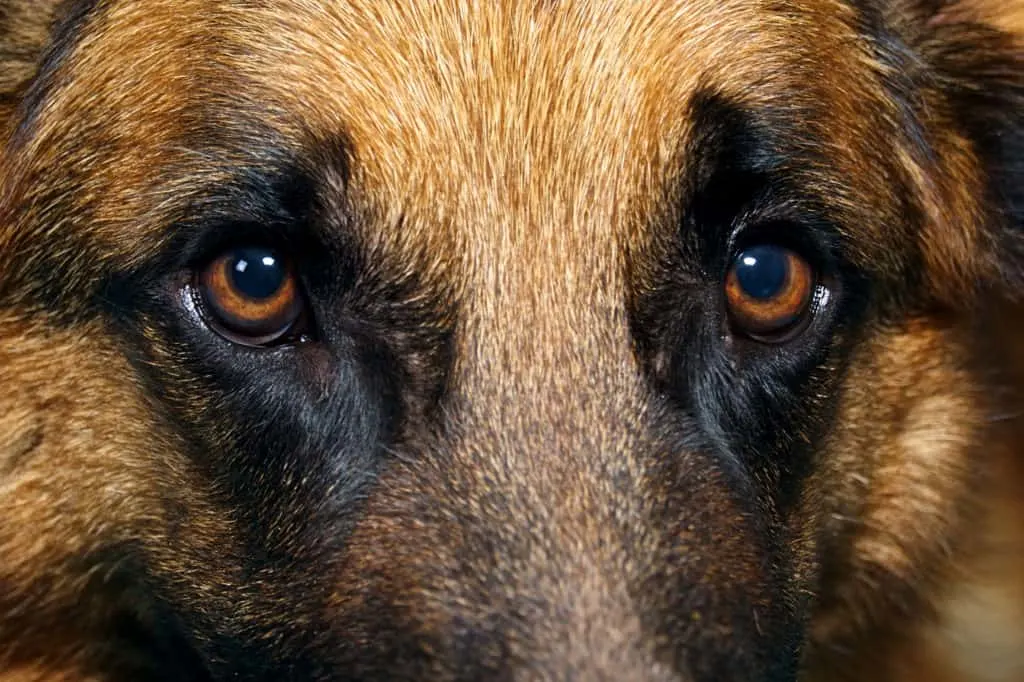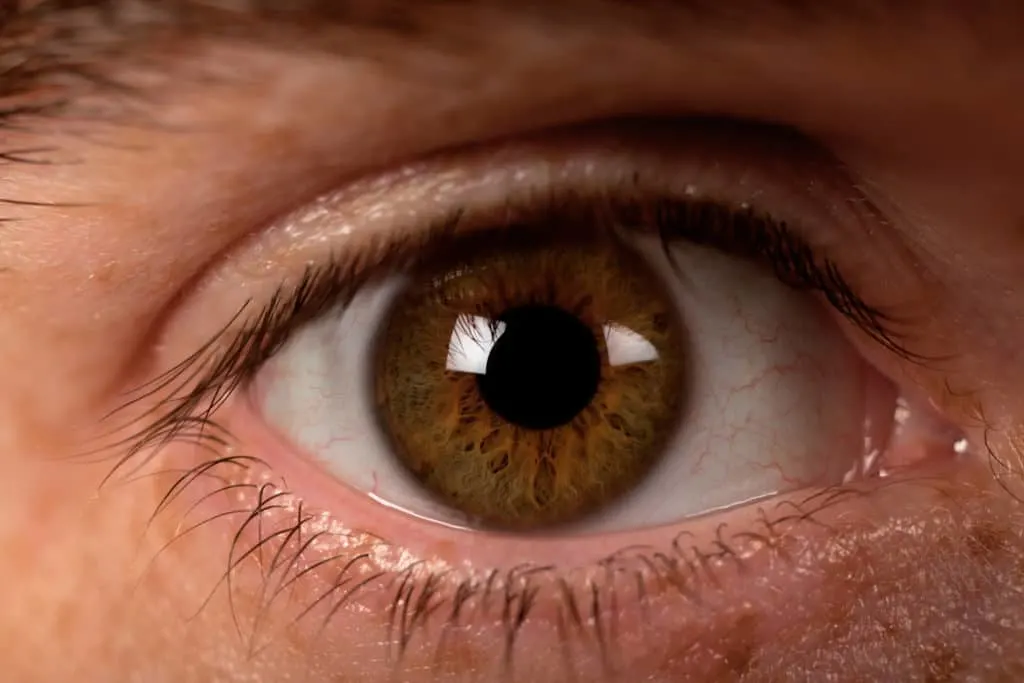
When it comes to how a dog sees, many of us have accepted the idea that all dogs are color blind. I know that I grew up believing that, and so did just about everyone I know. But the fact is that this information is simply not true.
Dogs are not color blind. While they cannot see the same colors as humans, dogs are able to perceive yellows, blues, and combinations of those colors.
In this article, we will take a closer look at just what color blindness is in humans, compare that to what a dog sees, as well as give you some helpful tips on how you can take your dog’s sight into consideration for purposes of play and training.
Click Here to Jump to a Section
What Is Color Blindness?
Color blindness, also known as color deficiency, occurs when a person is unable to see colors in a normal manner. The effect of color blindness is that a person will not be able to distinguish certain colors from one another.

Most commonly, this happens between red and green colors, but it does also occur less frequently with blue colors as well.
Every eye contains a retina, and in the retina there are two types of cells, rods and cones. Rods and cones detect light and color, respectively.
Rods are responsible for detecting light and dark. Cone cells, on the other hand, detect color.
When color blindness happens, it is because one or more of the cone cells that detect color are either missing, not working, or they are working improperly and detecting different colors than normal.
Color blindness is a blanket term, but there are actually different degrees of it. A person who has mild color blindness will be able to see color normally in good light, but they will have difficulty seeing colors in dim light.
A person with severe color blindness will not be able to distinguish certain colors no matter how good the light is.
At the extreme end, a colorblind person may not be able to distinguish any color at all and will see everything in shades of grey.
Dog and Human Eye Comparison
Color
The average human has trichromacy unless they are colorblind. What this means is that humans have cone receptors in their eyes that enable us to receive the 3 primary colors of light – red, green, and blue.
Trichromacy gives us the ability to see about 1,000,000 different shades and combinations of these colors.
In contrast to trichromacy in humans, dogs have what is called dichromacy. This means that they have cone receptors that are only able to perceive 2 different colors – blue and yellow.
This means that dogs can only perceive about 10,000 different colors, compared to about 1,000,000 in humans, and all of them being shades and combinations of only blue and yellow.
Field of Vision
While the inability to perceive and distinguish a wide range of colors is a disadvantage that dogs have compared to human vision, they do have a leg up on humans in terms of their field of vision.
A dog’s field of vision has everything to do with the placement of their eyes in relation to their head. Dogs’ eyes are located on the sides of their heads, and this gives them a much greater field of vision than humans.
A human has a field of vision of 190 degrees, but a dog’s field of vision is 250 degrees. This gives them much more peripheral vision than a human.

Green: Human Blind Spot

Green: Dog Blind Spot
On the other hand, dogs have only about half of the binocular vision as humans. A binocular visual field is where the visual field of both the left and right eyes intersect.
Binocular vision is how we are able to focus on and assess the distance of an object. In humans, because our eyes are located on the front of our heads, we have a much greater overlap in what we see from each eye, and this allows us to better judge distance than dogs.
Dogs have a binocular overlap of approximately 75 degrees compared to about 120 degrees in humans.
Night Vision
Another advantage that dog vision has over ours is seeing better in darker environments. Dogs have a decidedly better and more acute night vision than humans.
The reason for this is due to a combination of their eyes having more rods than that of the human eye, and it’s also due to them having a tapetum.
A tapetum acts similar to a mirror within a dog’s eye. Once light enters the eye, a dog’s tapetum reflects that light back and forth many more times than a human eye.
This gives a dog’s eyes the ability to absorb more light photons and therefore a dog will have a better ability than humans to see things in the dark.
This is also the reason that a dog’s eyes will often show up as bright and shiny in pictures taken of them in low light.
Motion
Because dogs have more rods in their eyes, they also have the ability to detect motion much better than humans.
Interesting fact: We’ve all experienced our dogs recognizing us from a distance and running up to enthusiastically greet us. We may think that our dogs just recognize us in the same way that we recognize them, but this is not the case.
The reason that your dog can recognize you from a distance is because she is highly accurate at detecting motion.
Your dog is not likely recognizing you by your face, but instead, she is doing so because her eyes allow her to be just that sensitive to your movements.
Visual Acuity
On the other hand, human vision holds the advantage over dog vision in terms of being able to see objects in the distance. The average human has 20/20 vision, but the average dog’s vision is 20/80.
What this means is that a dog would have to be 20 feet away from an object to see it as clearly as a human can from 80 feet away.
However, certain breeds, like the German Shepherds and Labradors (often used as guide dogs) are bred to have good vision and therefore can typically see better than other dog breeds.
So What Colors Is a German Shepherd Able to See?
It is now believed that a dog’s perception of color is similar to that of a person who has red-green color blindness. This is according to Jay Neitz, head of the Neitz Color Vision Lab at the University of Washington.
According to Neitz, dogs can distinguish yellow and blue colors and a combination of them.
An example of what this means for your dog, practically speaking, is that your thick, lively, and green lawn probably appears as what we would describe as a dead, uncared for lawn. Nonetheless, your dog won’t judge you for it!
Why Does All of This Matter to You and Your German Shepherd?
It’s nice to know how your dog sees and the different advantages and disadvantages the two of you have in comparison to one another, but let’s now apply this knowledge in a practical way.
You know that your dog can see certain colors and not others, so make sure that you are selecting products for your dog that are appropriately suited to her vision.




When choosing a toy for your German Shepherd, such as a ball, make sure to choose either blue or yellow. If you choose another color, it’s likely that your dog will have a more difficult time playing fetch and may even lose the ball in the grass.
Think twice the next time you feel that your dog could be doing a better job at playing fetch – it just might be you that could be doing a better job at selecting a ball to throw!
Many manufacturers of dog toys simply ignore a dog’s ability to see color in the production of their products. As you’ve undoubtedly noticed, many dog toys come in red, but that’s mainly for your benefit.
Most dog toy manufacturers are selling to your preferences, and not to your dog’s, so keep this in mind when choosing your dog’s next toy or training tool.
Also, take note the next time that you observe a dog agility competition. Most of the obstacles on a course will be colored either yellow or blue. This is no accident or coincidence – since these are the colors that a dog can actually see.
